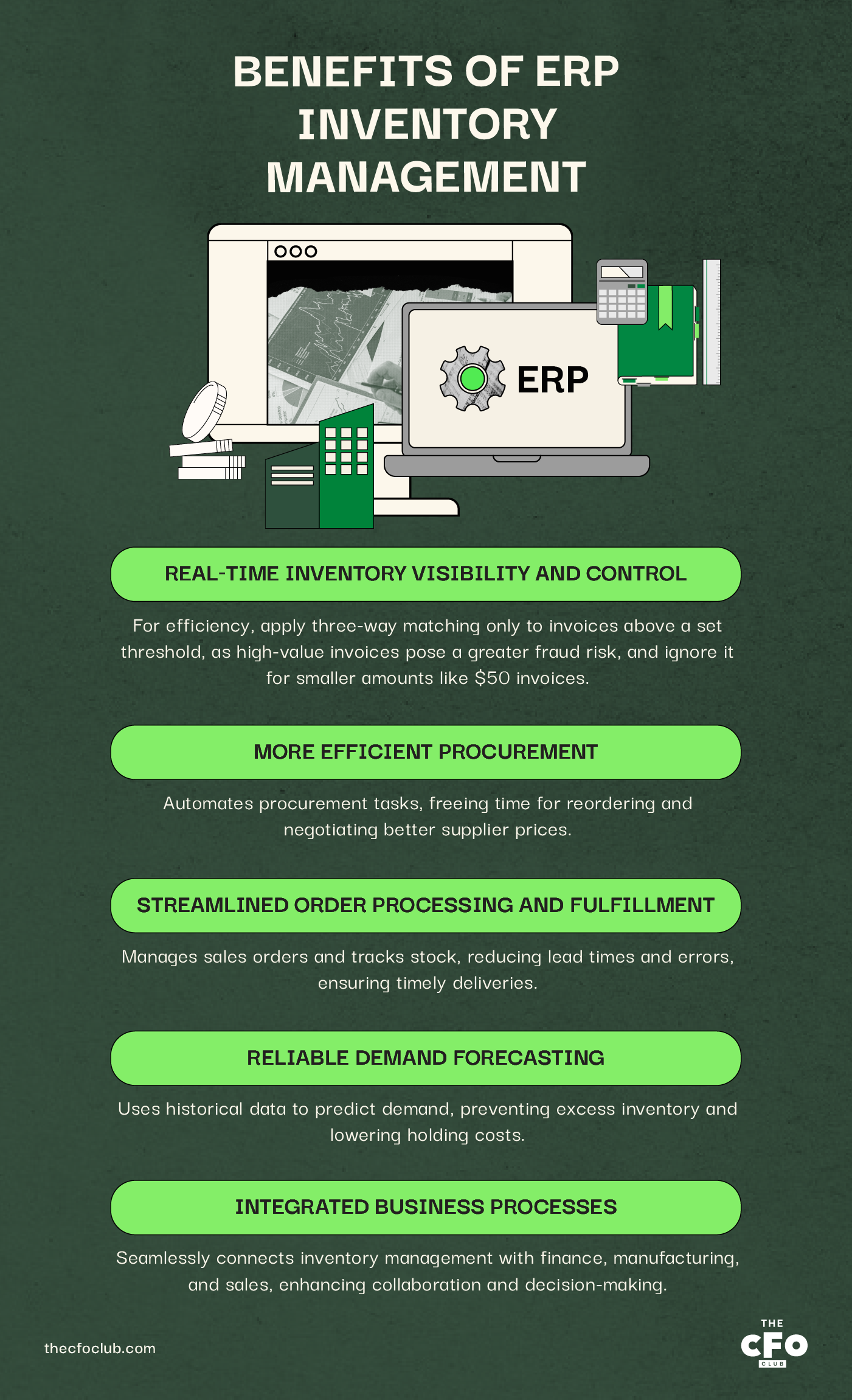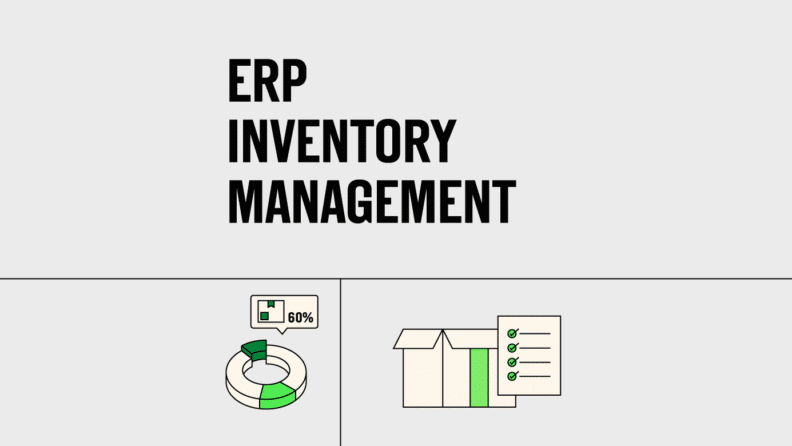If you’ve landed here after googling “ERP inventory management systems”, it's probably because you’re ready to ditch the paper lists and Excel spreadsheets. You want to start organizing your operations more effectively, and I’m proud of you!
Now begins the necessary job of migrating your manual records to digital via enterprise resource planning.
What Is ERP Inventory Management?
ERP inventory management is pretty much exactly what it sounds like: It’s the process of managing all your business operations and stock on one central platform.
ERP systems help you streamline various inventory management tasks, from financing and purchasing, all the way to warehouse management and order fulfillment.
Do You Need Inventory Management?
Inventory management typically becomes relevant for companies (that deal in the buying and selling of physical products) once they’re ready to mature into the “next phase” of growth.
While the markers that signify readiness for that “next phase” can vary quite a lot, there are a few questions to ask yourself to determine if you are in a good place to adopt an ERP system:
- Are you experiencing inconsistencies between actual and recorded inventory levels? If so, is this affecting your business operations?
- Is manually tracking inventory affecting your team’s productivity and giving you higher-than-average labor costs?
- Do you lack real-time visibility into inventory levels and movements, making it difficult to respond to fluctuating demand levels promptly?
If you answered yes to one or more of the above questions, ERP-based inventory management could be right for you.

Benefits Of ERP Inventory Management
Different types of ERP systems benefit various business departments. These include accounting, finance, HR, sales, customer support, and—of course, inventory management.
ERP inventory systems in particular streamline your business operations and boost efficiency, ultimately blocking cash leaks and maximizing profits.
Real-Time Inventory Visibility and Control
ERP systems offer detailed visibility into your inventory across multiple locations. They enable you to monitor stock levels, track orders, and find inaccuracies.
This enhanced view also ensures improved inventory control—limiting stockouts, shortages, overstocking, and accompanying costs.
More Efficient Procurement
An ERP system lets you automate procurement processes. These include making purchase orders, managing vendors, and tracking supplier performance.
Switching from manual procurement also frees you to focus on reordering and negotiating better prices with suppliers.
Streamlined Order Processing and Fulfillment
An ERP software simplifies order fulfillment, ultimately improving customer satisfaction. It does this by managing sales orders and inventory allocation, while also tracking stock movement from placement to delivery.
This automated process reduces your lead times, limits errors, and ensures timely product delivery.
Reliable Demand Forecasting
ERP systems give you access to historical data and consumer trends that help predict demand accordingly. Accurate demand forecasts will prevent excess inventory, ensuring you aren’t spending excessively on holding costs.
Integrated Business Processes
Using an ERP system lets you seamlessly integrate inventory management with other core business operations like finance, manufacturing, and sales. These integrations allow for smooth data flow across departments, aiding collaboration and decision-making.
There are other big, juicy benefits that come as a result of using ERP systems but, for the sake of this article, we’ll keep our focus on inventory management.
Main Features Of ERP Inventory Management
The best ERP systems for inventory and supply chain management have one thing in common—well, actually, they have these five things in common:
1. Inventory Tracking
Every good ERP inventory management solution will have robust inventory tracking capabilities. This feature helps you monitor the stock you have on hand and stay prepared for any changes in demand and supply.
2. Procurement and Replenishment
The procurement and replenishment functionality covers tasks like creating purchase orders, vendor relationship management, and supplier performance monitoring. This feature ensures you’re never out of stock or overstocked.
3. Order Management
The order management feature enables you to generate new order records and track their status till they get to the customer.
It also allows you to pull individual product history and information as needed, without having to dig back through a bunch of fractured systems.
4. Forecasting and Planning
Forecasting and planning features help you predict future inventory needs. They ensure you keep the required stock levels by analyzing historical data, sales projections, and market trends.
5. System Integration
The best ERP inventory software ensures organization-wide alignment by linking inventory management to other business functions, thereby enabling smooth integrations between tools.
Most importantly, ERP inventory management isn’t typically expected to operate as a standalone activity. It serves as part of a unified system for improving business efficiency.
Additional ERP Features For Inventory Management
The features listed above will always be most important. But, here are some great, non-essential features to look for when selecting an ERP system.
| Analytics and reporting | Shows accurate current and historical inventory data |
| Mobile compatibility | Enables inventory management on the go |
| User access control | Restricts visibility of sensitive inventory data |
| Returns management | Keeps track of returned stock, refunds, and repairs |
| Automated alerts | Flags critical stock levels and reorder points |
| Scalability | Customizable to fit growing business needs |
| Quality checks | Logic or rules for quality assurance |
| Barcoding and tagging | Aids product tracking and limits human error |
| Multi-location management | Accounts for stock in multiple warehouses |
| Batch and expiry tracking | Prevents losses on perishable goods |
| Warehousing | Streamlines warehouse automation |
| Customer relationship management (CRM) | Improves the customer experience |
How to Select an Inventory-Focused ERP System
Now that you know what to look for in the ideal solution, I want to help you use whichever ERP software you choose optimally.
Step 1 - Define Business Requirements
Meet with key stakeholders to understand your business’s inventory management needs. Then, put together an ERP implementation team. This team could include warehouse managers, procurement teams, and finance personnel.
You can also enlist other teammates you consider relevant to determining comprehensive requirements. Or, employ the services of an ERP consultant to make the entire process easier on yourself and your team.
Step 2 - Set Goals and Allocate a Budget
Technically, this is two steps:
- Outline specific goals for your new ERP inventory software.
- Determine how much money you can afford to spend on it.
If you don’t know exactly where to start with goal-setting, consider setting specific goals around improved inventory accuracy, higher order fulfillment rates, reduced lead times, and similar items.
If you’re having trouble getting buy-in on a realistic budget, consider running a cost benefit analysis and sharing the results with the other stakeholders involved in this decision.
Step 3 - Select an ERP Inventory Management Solution
Keeping your requirements and budget in mind, check out different ERP software and providers.
Focus on options that have your desired functionality, then create a shortlist of systems you want to dig deeper into. Alternatively, you can get in touch with my team to help guide you toward the systems that would best suit your needs.
10 Best ERP Inventory Management Solutions
Here's my pick of the 10 best software from the 10 tools reviewed.
Step 4 - Design and Configure Workflows for the New System
Work with your project team to design and develop workflows for all your inventory management processes. You’ll want to start out by:
- Analyzing and customizing modules,
- Setting data parameters,
- Defining user access controls, and
- Setting up cross-functional tool integrations.
Step 5 - Conduct Comprehensive User Testing
Before going live with the new ERP system, make sure people other than you get how it works. Do this by having colleagues from different departments test your new setup.
This can be as simple as getting someone from the procurements team to test the purchase order workflow—while it’s inevitable that they’ll have questions, they shouldn’t have major concerns.
Take note of feedback and fix any issues or bugs before moving forward.
Step 6 - Deploy the Solution and Train Users
Deployment time. Get the system live and in the hands of all relevant members of your inventory management team(s).
Be sure to walk through all operational changes with your team, and consider having the vendor give in-person or virtual training beforehand. This is another step that’s easy to write off, but if you do, I can just about promise that you’ll get less of a return on your investment here.
After the rollout, pick "change champions" from each department or keep your implementation team active a little longer. Lean on these people to gather hands-on feedback and help tackle any challenges that present themselves.
Step 7 - Provide Ongoing Support and Maintenance
Research the type of support your ERP vendor provides and monitor their software updates so you can keep your team up to speed at all times. Also, continuously track system performance and make needed changes for optimal productivity.
Upgrade Your Business With ERP Inventory Management
If you’ve made it this far, I’m willing to bet this topic is extraordinarily relevant to you, so… Why wait? Look into ERP systems for your inventory management needs, then watch as your life gets a wee bit simpler.
Ready to compound your abilities as a finance leader? Subscribe to our newsletter for expert advice, guides, and insights from finance leaders shaping the tech industry.


